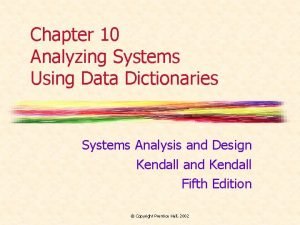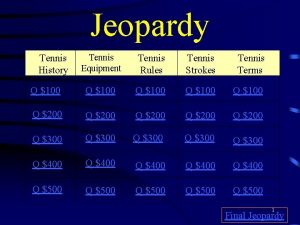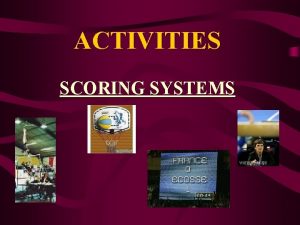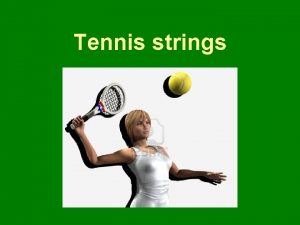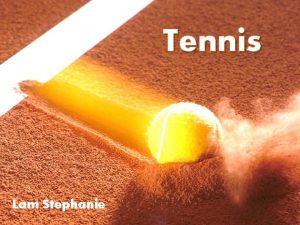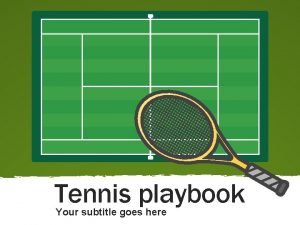Analyzing tennis scoring systems from the origins to



















- Slides: 19

Analyzing tennis scoring systems: from the origins to today Tristan Barnett Adjunct Research Fellow University of South Australia


Reaching 6 -6 from outset - 75. 2% Reaching 68 -68 from outset - 3. 5% Reaching 68 -68 from 6 -6 - 4. 7% www. strategicgames. com. au

Introduction Long matches can cause problems for tournaments (scheduling of matches, broadcasting, staff) Can be unfair in the tournament setting Can also lead to injuries to the participating players History of tennis scoring systems Factors causing long matches Scoring systems Conclusions

History of tennis systems Why does a game of tennis contain four points to win followed by deuce if the scores are level after six points have been played? Would tennis be different if the next player to win the point if deuce is obtained is the winner? Or an unbalanced game that required the server to win four points and the receiver to win three points without actually playing a deuce? Why does the US Open play a tiebreak deciding set, whereas the other three grand slam events use an advantage final set? Has changes in playing equipment, court dimensions, surface composition and player

History of tennis systems Origins of tennis Various theories have been given for the origins of tennis. One theory is that the game was given to the French Royal Court in the 10 th century by a wandering minstrel. By the 11 th century early tennis was being played in French monasteries. Hands were used to hit the ball to begin with; gloves were used later on and during the 13 th century players started to use short bats. The French called this form of tennis jeu de paume, meaning “the game of the palm” because it was originally played with the hand, and what was called Real Tennis in Britain, Court Tennis in the

History of tennis systems Royal Tennis Royal tennis can be traced back at least as far as 1490 in Urrungne France, which is possibly the oldest court in the world (Garnett, 1999). The structure of a game which was recognized in 15 th century tennis is still being used in Royal Tennis today and has carried through to Lawn Tennis. Sets however are played first-to-six games wins the set, even if the opponent has five games. A match is typically best-of-three sets, except for the major open tournaments, in which matches are best-of-five sets. One fault is allowed on serve and a double fault results in the server losing the point.

History of tennis systems Lawn Tennis – singles Lawn Tennis can be traced back to 1858, with the first lawn tennis club formed in Leamington in 1872, and the first official championships played in 1877 at Wimbledon. Originally in Lawn Tennis all sets were advantage where a player needed six games to win the set. If the score reached five games all, the set continued indefinitely until a player was two games ahead and won the set. Another change from Royal Tennis is the rotation of service, where players rotate service after the completion of each game. The tiebreak was invented by Jimmy Van Alen in 1965 to reduce the length of

History of tennis systems Lawn Tennis – doubles In 2001 the Australian Open replaced the final set of mixed doubles with a match tiebreak (first to 10 points and win by 2 points wins the match). The US Open and the French Open have since gone on to join the Australian Open in using the same format for mixed doubles. Wimbledon continues to play a traditional best-ofthree set match with the final set being an advantage set. In 2006 there was a change to the best-of-three sets scoring system used for doubles in men’s and women’s doubles tournaments on the main tour (excluding grand slam events). The system now used for these tournaments is a best-of-three sets system

Factors causing long matches Percentage of points won on serve Haake et al (2007) concludes that if a player used rackets and balls from the 1870’s, 1970’s and 2007, then serve speeds would have increased by 17. 5% since the

Factors causing long matches Percentage of points won on serve With the advantage final set used at Wimbledon, Australian Open and the French Open, this gives some justification to show why long matches can occur in men’s

Factors causing long matches Percentage of points won on serve In the quarter-finals of the 2003 Australian Open men’s singles, Andy Roddick defeated Younes El Aynaoui 21– 19 in the fifth set, a match taking 83 games to complete and lasting a total duration of 5 h. The night session containing this long match required the following match to start at 1 am. Barnett and Clarke (2005) give a detailed analysis of this Roddick versus El Aynaoui match and conclude that whenever two players with dominant serves but relatively poor returns of serve meet, there is always a chance that if the match reaches a fifth set, it can go on for a long period of time. They showed from pre-match predictions

Factors causing long matches Length of time to play a point Average length of time in the first four sets is 55. 8, which suggests that best-of-five set matches with all tiebreak sets can still produce long matches.

Scoring Systems Characteristics Many papers appear in the literature in comparing scoring systems for tennis (Brown et al 2008 a, Pollard et al 2007, Pollard and Noble 2004). Typical characteristics to make comparisons for these scoring systems are: (i) P(A wins) where A is the better player/pair (ii) Mean number of points in the match (iii) Standard deviation of the number of points in the match (iv) Efficiency of the scoring system (v) 98% point of the cumulative distribution of the number of points

Scoring Systems

Scoring Systems Results

Scoring Systems Recommendations The 50 -40 game as outlined in Pollard and Noble (2004) is such that to win the game, the server requires four points and the receiver requires three points. There is at most six points played in this type of game.

Conclusions The history of tennis scoring systems, possible factors causing long matches, examples of long matches that have occurred in recent times and numerical results for characteristics of scoring systems are given in this paper. Based on this information, recommendations of scoring systems are given for men’s and women’s singles and doubles events that could be used for today. References Barnett T and Clarke SR (2005). Combining player statistics to predict outcomes of tennis matches. IMA Journal of Management Mathematics. 16 (2), 113 -120. Garnett M (1999). A chase down under: a history of royal tennis in Australia. Historical Publications. Haake S, Allen T, Choppin S and Goodwill S (2007). The evolution of the tennis racket and its effect on serve speed. Tennis Science and Technology 3. Roehampton. S.

ICORES 2012
 10 rules of tennis
10 rules of tennis Tennis scoring history
Tennis scoring history A high arching shot landing near the baseline is called?
A high arching shot landing near the baseline is called? Scored script examples
Scored script examples Data dictionary example in system analysis and design
Data dictionary example in system analysis and design Hình ảnh bộ gõ cơ thể búng tay
Hình ảnh bộ gõ cơ thể búng tay Lp html
Lp html Bổ thể
Bổ thể Tỉ lệ cơ thể trẻ em
Tỉ lệ cơ thể trẻ em Voi kéo gỗ như thế nào
Voi kéo gỗ như thế nào Tư thế worm breton là gì
Tư thế worm breton là gì Alleluia hat len nguoi oi
Alleluia hat len nguoi oi Môn thể thao bắt đầu bằng chữ đua
Môn thể thao bắt đầu bằng chữ đua Thế nào là hệ số cao nhất
Thế nào là hệ số cao nhất Các châu lục và đại dương trên thế giới
Các châu lục và đại dương trên thế giới Công thức tính thế năng
Công thức tính thế năng Trời xanh đây là của chúng ta thể thơ
Trời xanh đây là của chúng ta thể thơ Mật thư tọa độ 5x5
Mật thư tọa độ 5x5 101012 bằng
101012 bằng độ dài liên kết
độ dài liên kết




